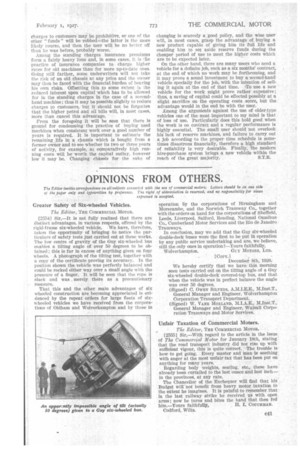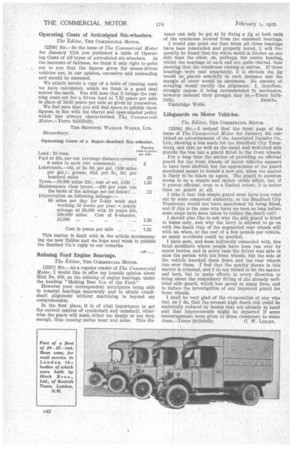OPINIONS FROM OTHERS.
Page 63

Page 64

If you've noticed an error in this article please click here to report it so we can fix it.
The Editor invites corresPondence on all subjects connected with the use of commercial motors. Letters should be on OW side of the paper only and typewritten by Preference. The right of abbreviation is reserved, and no responsibility for views
expressed is accepted,
Greater Safety of Six-wheeled Vehicles.
The Editor, THE COMMERCIAL MOTOR.
[2554] Sir,—It is not fully realized that there are distinct advantages, in various respects, offered by the rigid-frame six-wheeled vehicle. We have, therefore, taken the opportunity of bringing to notice the particulars of safety tests just carried out at these works. The low centre of gravity of the Guy six-wheeled bus enables a tilting angle of over 50 degrees to be obtained; this is far in excess of anything given on four wheels. A photograph of the tilting test, together with a copy of the certificate proving its accuracy. In the position shown the vehicle was perfectly balanced and could be rocked either way over a Small angle with the pressure of a finger. It will be seen that the rope is slack and was merely there as a precautionary measure.
That this and the other main advantages of six wheeled construction are becoming appreciated is evidenced by the repeat orders for large fleets of sixwheeled vehicles we have received from the corporations of Oldham and Wolverhampton and by those in operation 15y the corporations of Birmingham and Morecambe, and the Norwich Tramway Co., together with the orders on hand for the corporations of Sheffield, Leeds, Liverpool, Salford, Reading, National Omnibus Co., Cumberland Motor Services and the Rio de Janeiro Tramways.
In conclusion, may we add that the Guy six-wheeled double-deck buses were the first to be put in operation by any public service undertaking and are, we believe, still the only ones in operation?—Yours faithfully, Wolverhampton. GUY MOTORS, LTD.
COPY.] December 8th, 1028.
We hereby certify that we have this morning seen tests carried out on the tilting angle of a Guy six-wheeled double-deck covered-top bus, and that when the vehicle was in perfect balance the angle was over 50 degrees.
(Signed) C. OWEN SILVERS, A..M.I.E.E., General Manager and Engineer, Wolverhampton Corporation Transport Department.
(Signed) W. VANE MORLAND, M.I.A.E., General Manager and Engineer, Walsall Corporation Tramways and Motor Services.
Unfair Taxation of t:onunercial Motors.
The Editor, THE COMMERCIAL MOTOR., 125551 Sir,—With regard to the article in the issue of The Commercial Motor for January 18th, stating ' that the road transport industry did not rise up with sufficient vigour, this is quite correct. The trouble is how to get gang. Every master and *man is• seething with anger at the most unfair tax that has been put on anything for many years.
Regarding body weights, seating, etc., these have already been curtailed to the last ounce and last inch— in the provinces, at any rate. The Chancellor of the Exchequer will find that his Budget will notbenefit from heavy motor taxation to the extent he imagines. It is painful to remember that in the last railway strike he received us with open arms; now he turns and bites the hand that then fed
THE COMMERCIAL MOTOR Operating Costs of Articulated Six-wheelers.
The tditor, THE COMMERCIAL MOTOR.
125561 Sir,—In the issue of The Commercial Motor for January 11th you published a table of Operating Costs of all.types of articulated six-wheelers. In the interests of fairness, we think it only right to point out to you that the figures given for steam-driven vehicles are, in our opinion, excessive and misleading and should be amended.
We attach hereto a copy of a.table of running costs we have calculated, which we think is a good deal nearer the mark. You will note that it brings the running costs out for a 10-ton load at 7.32 pence per mile in place of 10,50 pence per mile as given by yourselves.
We feel sure that you will find space to publish these figures, in line with the liberal and open-minded policy which has always characterized The. Commercial Motor.—Yours faithfully,
THE SENTINEL WAGGON WORKS, LTD.
Shrewsbury.
Operating Costs of a Super-Sentinel Six-wheeler.
Running •
i
•
i
per in pence
Load: 10 tons.
Fuel at 45s. per ton (average distance covered 9 miles to each cwt. consumed) ... ... 3 Lubricants.—Oil, at 2s. 9d. per gal. (100 miles per gal.) ; grease, Bid. per lb., 3d. per hundred miles .36 Tyres.-16,000 miles life; cost of set, £130 ... 1.95 Maintenance (less tyres).—£60 per year (on the basis of the mileage set out below) ... .72 Depreciation on following mileage :— 80 miles per day for 5-4ay week and working 50 weeks per year = yearly mileage at 20,000 with 10 yearslife, 200,000 miles. Cost of 6-wheeler, £1,080 ... 129, Cost in pence per mile ... 7,32 This matter is dealt with in the article accompanying the new Tables and we hope next week to publish the Sentinel Co.'s reply to our remarks.
Relining Ford Engine Bearings.
The Editor, THE COMMERCIAL MOTOR.
[2557] Sir,—As a regular reader of The Commercial Motor, I would like to offer my humble opinion about Hint No. 476, on the relining of engine bearings, under the heading "Making Best Use of the Ford."
However your correspondent anticipates being able to remetal bearings separately and to obtain crankshaft alignment without machining is beyond my comprehension.
In the first place, it is of vital importance to get the correct centres of crankshaft and camshaft, otherwise the gears will mesh either too deeply or not deep enough, thus causing undue wear and noise. This dis
tame can only be got at by fixing a jig at both ends of the crankcase located from the camshaft bearings.
I would also point out that when all three bearings have been remetalled and properly bored, it will frequently be found that the white metal is thicker on one side than the other, on, perhaps, the centre bearing, whilst the bearings at each end are quite central, thus showing that the crankcase casting is untrue. If these bearings weie cast separately, it is obvious the jig would be, placed centrally in each instance and the margin of error would be enormous. No amount of scraping would rectify the alignment. I, therffore, strongly oppose it being recommended to mechanics, however isolated their garages may be.—YOurs
SNIKTA.
Tunbridge Wells.
Lifeguards on Motor Vehicles.
The Editor, THE COMMERCIAL MOTOR.
[2558] Sir,—I noticed that the front page of the issue of The Commercial Motor for January. 4th contained an advertisement of the Associated Daimler Co., Ltd., showing a bus made for the Bradford City Tramways, and that as well as the usual and well-tried side guards the bus has a guard fitted to the front wheels.
For a long time the matter of providing an efficient guard for the front wheels of motor vehicles appears to have been shelved, but the appearance of the guard mentioned seems to herald a new era, when the matter is likely to be taken up again. The guard in question seems to be a simple and rather crude affair, but, if it proves efficient, even to a limited extent, it is better than no guard at all.
I take it that this simple guard must have been tried out by some competent authority, or the Bradford City Tramways would not have sanctioned its being fitted, and if this is the case why have we been so long before some steps have -been taken to reduce the death roll?
I should also like to ask why the side guard is fitted to buses only, and why the lorry is allowed to go on with the death trap of the unguarded rear wheels still with us, when, at the cost of a few pounds per vehicle, so many accidents could be avoided.
I have seen, and been indirectly connected with, five fatal accidents where people have been run over by motor lorries, and in every case the driver was able t6 miss the person with his front wheels, but the side of the vehicle knocked them down and the rear wheels ran over them. -I feel that the apathy shown in this matter is criminal, and I do not intend to let the matter end here, but to make efforts in every direction to bring about the compulsory fitting of the already welltried side guard, which has saved so many lives, and to induce the investigation of any improved guard for front wheels.
I shall be very glad of the co-operation of any who feel, as I do, that the present high death roll could be materially reduced by means that are already at hand and that improvements might be expected if some encouragement were given to those competent to make
them.—Yours faithfully, C. W. LINLEY.


































































































